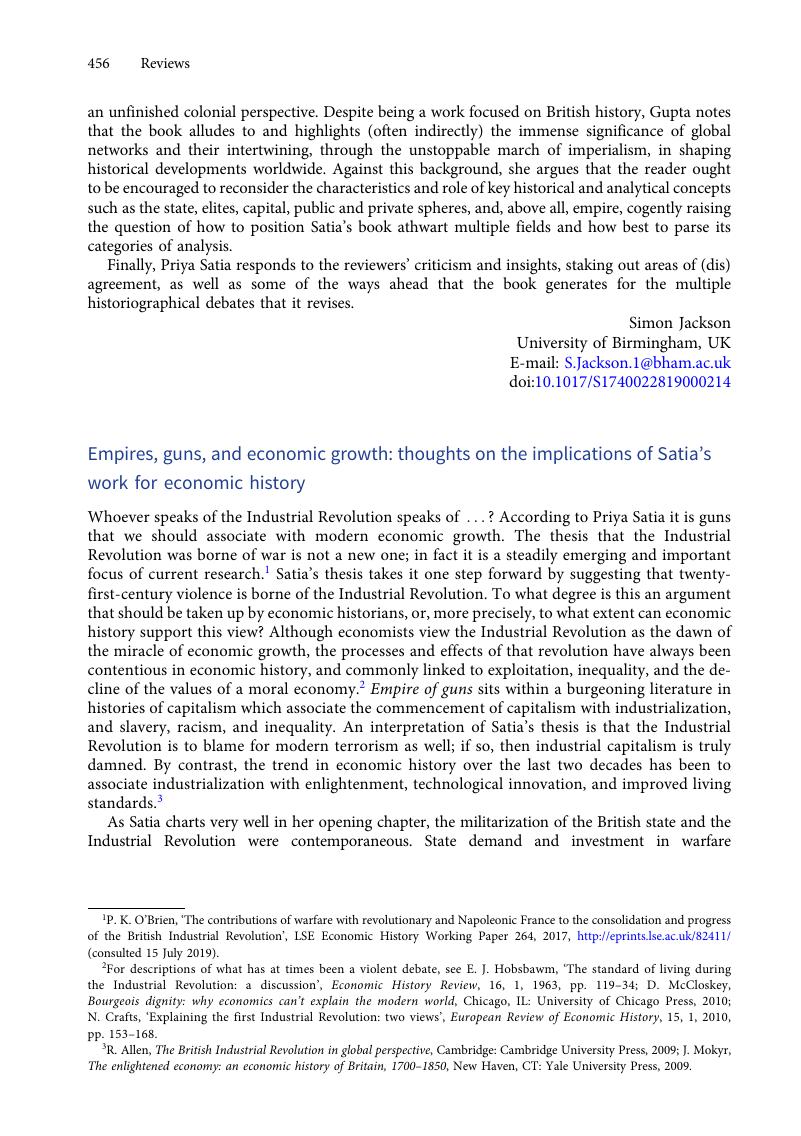No CrossRef data available.
Published online by Cambridge University Press: 21 October 2019

1 P. K. O’Brien, ‘The contributions of warfare with revolutionary and Napoleonic France to the consolidation and progress of the British Industrial Revolution’, LSE Economic History Working Paper 264, 2017, http://eprints.lse.ac.uk/82411/ (consulted 15 July 2019).
2 For descriptions of what has at times been a violent debate, see Hobsbawm, E. J., ‘The standard of living during the Industrial Revolution: a discussion’, Economic History Review, 16, 1, 1963, pp. 119–34CrossRefGoogle Scholar; McCloskey, D., Bourgeois dignity: why economics can’t explain the modern world, Chicago, IL: University of Chicago Press, 2010 CrossRefGoogle Scholar; Crafts, N., ‘Explaining the first Industrial Revolution: two views’, European Review of Economic History, 15, 1, 2010, pp. 153–168 CrossRefGoogle Scholar.
3 Allen, R., The British Industrial Revolution in global perspective, Cambridge: Cambridge University Press, 2009 CrossRefGoogle Scholar; Mokyr, J., The enlightened economy: an economic history of Britain, 1700–1850, New Haven, CT: Yale University Press, 2009 Google Scholar.
4 Inikori, Joseph E., Africans and the Industrial Revolution in England: a study in international trade and economic development, Cambridge: Cambridge University Press, 2002 CrossRefGoogle Scholar.
5 For detail on this point, see O’Brien, ‘Contributions of warfare’, p. 47.
6 Braunstein, P., ‘Innovations in mining and metal production in the late Middle Ages’, Journal of European Economic History, 12, 3, 1983, pp. 573–91Google Scholar; Hamilton, E. J., War and prices in Spain, 1650–1800, New York: Russell & Russell, 1969 Google Scholar.
7 Hudson, P., The Industrial Revolution, London and New York: E. Arnold, 1992 Google Scholar; Hudson, P., ed., Regions and industries: a perspective on the Industrial Revolution in Britain, Cambridge: Cambridge University Press, 1989 CrossRefGoogle Scholar; Allen, Robert C., ‘The Industrial Revolution in miniature: the spinning jenny in Britain, France, and India’, Journal of Economic History, 69, 4, 2009, pp. 901–27CrossRefGoogle Scholar.
8 Collins, E. T. J., ‘At the cutting edge: edge tool production in southern and south-west England, 1740 to 1960’, Agricultural History Review, 64, 2017, pp. 196–225Google Scholar.
9 Clegg, H. A., Fox, A., and Thompson, A. F., A history of British trade unions since 1889, vol. 1, 1889–1910, Oxford: Clarendon, 1964 Google Scholar.
10 Pollard, S., The genesis of modern management: a study of the Industrial Revolution in Great Britain, London: Edward Arnold, 1965 Google Scholar.
11 Broadberry, S. N. et al., British economic growth, Cambridge: Cambridge University Press, 2015 Google Scholar; Crafts, N. and Mills, T. C., ‘Six centuries of British economic growth: a time-series perspective’, European Review of Economic History, 21, 2017, pp. 141–58CrossRefGoogle Scholar.
12 Craft and Mills, ‘Six centuries’.